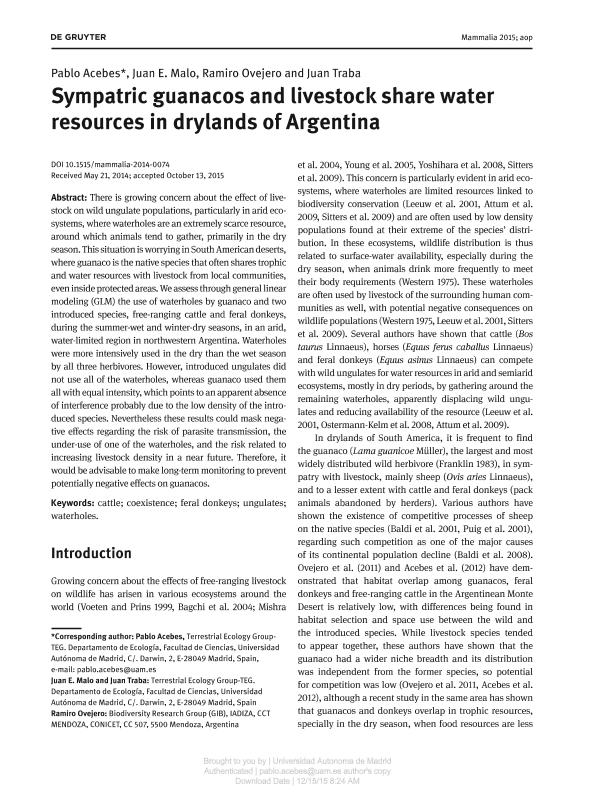Mostrar el registro sencillo del ítem
dc.contributor.author
Acebes, Pablo
dc.contributor.author
Malo, Juan E.
dc.contributor.author
Ovejero Aguilar, Ramiro Jose Antonio

dc.contributor.author
Traba, Juan
dc.date.available
2019-12-17T22:32:28Z
dc.date.issued
2016-08
dc.identifier.citation
Acebes, Pablo; Malo, Juan E.; Ovejero Aguilar, Ramiro Jose Antonio; Traba, Juan; Sympatric guanacos and livestock share water resources in drylands of Argentina; De Gruyter; Mammalia; 80; 5; 8-2016; 491-496
dc.identifier.issn
0025-1461
dc.identifier.uri
http://hdl.handle.net/11336/92452
dc.description.abstract
There is growing concern about the effect of livestock on wild ungulate populations, particularly in arid ecosystems, where waterholes are an extremely scarce resource, around which animals tend to gather, primarily in the dry season. This situation is worrying in South American deserts, where guanaco is the native species that often shares trophic and water resources with livestock from local communities, even inside protected areas. We assess through general linear modeling (GLM) the use of waterholes by guanaco and two introduced species, free-ranging cattle and feral donkeys, during the summer-wet and winter-dry seasons, in an arid, water-limited region in northwestern Argentina. Waterholes were more intensively used in the dry than the wet season by all three herbivores. However, introduced ungulates did not use all of the waterholes, whereas guanaco used them all with equal intensity, which points to an apparent absence of interference probably due to the low density of the introduced species. Nevertheless these results could mask negative effects regarding the risk of parasite transmission, the under-use of one of the waterholes, and the risk related to increasing livestock density in a near future. Therefore, it would be advisable to make long-term monitoring to prevent potentially negative effects on guanacos.
dc.format
application/pdf
dc.language.iso
eng
dc.publisher
De Gruyter

dc.rights
info:eu-repo/semantics/openAccess
dc.rights.uri
https://creativecommons.org/licenses/by-nc-sa/2.5/ar/
dc.subject
CATTLE
dc.subject
COEXISTENCE
dc.subject
FERAL DONKEYS
dc.subject
UNGULATES
dc.subject
WATERHOLES
dc.subject.classification
Ecología

dc.subject.classification
Ciencias Biológicas

dc.subject.classification
CIENCIAS NATURALES Y EXACTAS

dc.title
Sympatric guanacos and livestock share water resources in drylands of Argentina
dc.type
info:eu-repo/semantics/article
dc.type
info:ar-repo/semantics/artículo
dc.type
info:eu-repo/semantics/publishedVersion
dc.date.updated
2019-08-27T19:09:50Z
dc.journal.volume
80
dc.journal.number
5
dc.journal.pagination
491-496
dc.journal.pais
Alemania

dc.journal.ciudad
Berlin
dc.description.fil
Fil: Acebes, Pablo. Universidad Autónoma de Madrid; España
dc.description.fil
Fil: Malo, Juan E.. Universidad Autónoma de Madrid; España
dc.description.fil
Fil: Ovejero Aguilar, Ramiro Jose Antonio. Consejo Nacional de Investigaciones Científicas y Técnicas. Centro Científico Tecnológico Conicet - Mendoza. Instituto Argentino de Investigaciones de las Zonas Áridas. Provincia de Mendoza. Instituto Argentino de Investigaciones de las Zonas Áridas. Universidad Nacional de Cuyo. Instituto Argentino de Investigaciones de las Zonas Áridas; Argentina
dc.description.fil
Fil: Traba, Juan. Universidad Autónoma de Madrid; España
dc.journal.title
Mammalia

dc.relation.alternativeid
info:eu-repo/semantics/altIdentifier/doi/https://doi.org/10.1515/mammalia-2014-0074
dc.relation.alternativeid
info:eu-repo/semantics/altIdentifier/url/https://www.degruyter.com/view/j/mamm.2016.80.issue-5/mammalia-2014-0074/mammalia-2014-0074.xml
Archivos asociados
